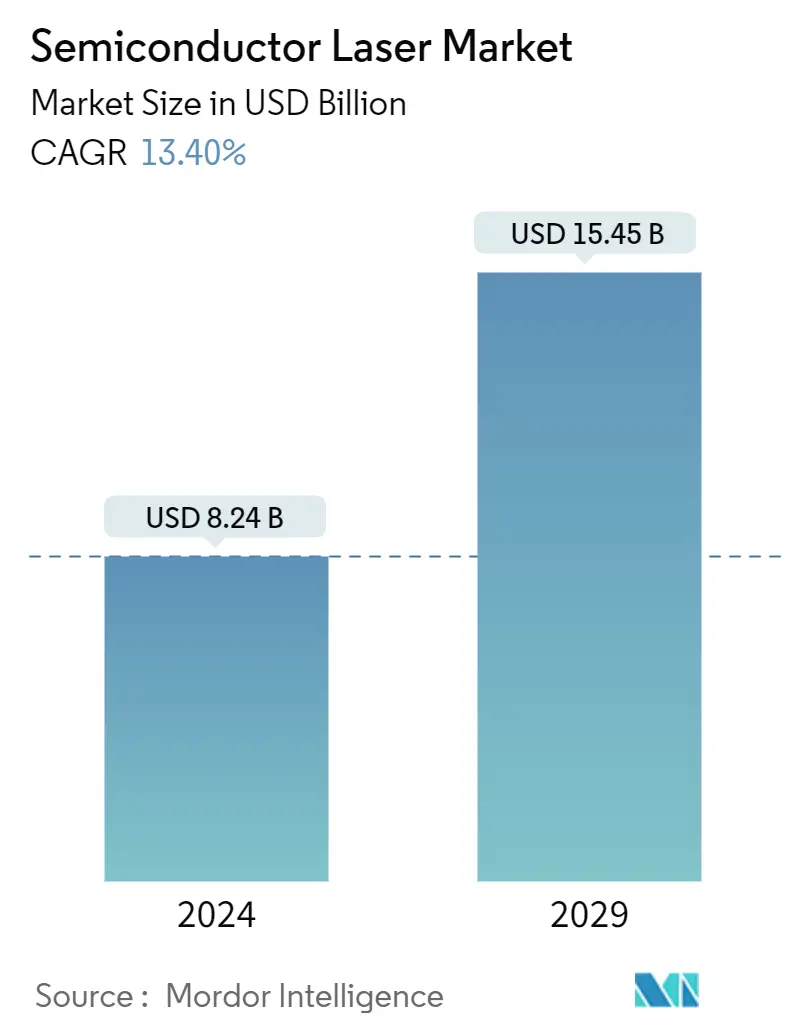Market Size of Semiconductor Laser Industry

| Study Period | 2019 - 2029 |
| Market Size (2024) | USD 8.24 Billion |
| Market Size (2029) | USD 15.45 Billion |
| CAGR (2024 - 2029) | 13.40 % |
| Fastest Growing Market | Asia Pacific |
| Largest Market | Asia Pacific |
Major Players*Disclaimer: Major Players sorted in no particular order |
Need a report that reflects how COVID-19 has impacted this market and its growth?
Semiconductor Laser Market Analysis
The Semiconductor Laser Market size is estimated at USD 8.24 billion in 2024, and is expected to reach USD 15.45 billion by 2029, growing at a CAGR of 13.40% during the forecast period (2024-2029).
A semiconductor laser, also known as a laser diode and diode laser, is a type of laser that utilizes a semiconductor material as its active medium. It is a subset of the larger classification of semiconductor pn junction diodes. Semiconductor lasers are typically small, often about the size of a grain of salt. They are solid-state lasers based on semiconductor gain media, where optical amplification is achieved through stimulated emission at an interband transition under conditions of high carrier density in the conduction band.
The working principle of a semiconductor laser involves the injection of charge carriers (electrons and holes) into a pn junction formed within the semiconductor material. When a forward electrical bias is applied across the laser diode, charge carriers are injected from opposite sides of the pn junction into the depletion region. This injection of charge carriers creates a population inversion, where more electrons occupy the higher energy levels than the lower energy levels. When the electrons in the conduction band recombine with holes in the valence band, they emit photons through stimulated emission, resulting in the generation of laser light.
- Semiconductor lasers offer several advantages that make them widely used in various industries. Semiconductor lasers consume less power compared to typical lighting techniques, making them more energy-efficient. They have a long operational life, making them suitable for long-term use. Semiconductor lasers are small and lightweight, making them easy to handle and integrate into different systems. Semiconductor lasers are relatively inexpensive, making them cost-effective for everyday use. They are also simple to operate, even though their design may seem complex on a small scale.
- One of the key drivers of the rise in demand for semiconductor laser applications is the rising demand for data transfer speed. As more data is created through digitalization and the internet of Things (IoT), there is a need for faster data transfers. This presents a sizeable opportunity for the component for the component manufacturers that specialize in optical communication products.
- A fiber laser is a solid-state laser that generates a high-intensity laser beam through stimulated emission. The laser utilizes an optical fiber as the gain medium or the source of laser light amplification. The core of a fiber laser consists of a specially designed optical fiber, often doped with rare-earth elements such as erbium, neodymium, or ytterbium. These dopants provide the necessary energy levels for the laser to operate. The fiber is surrounded by a cladding layer that helps confine and guide the light within the core.
- One of the crucial factors for the usage of the semiconductor laser is reliability. The products require constant temperature and constant current to ensure stable output power. Any lack of control of the electric circuit can cause the product to malfunction and hamper the device in which it is used.
- The COVID-19 pandemic disrupted the semiconductor supply chain, which impacted the manufacturing of optical transceivers. Semiconductor fabs across the globe have been severely impacted by the restrictions in manufacturing and supply brought about by the pandemic.
